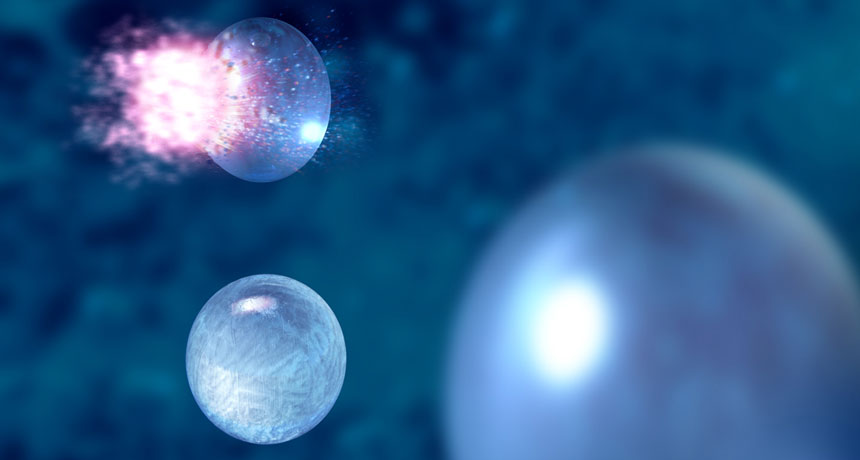Very-sub-zero water
Supercooled water can stay liquid far below its normal freezing point

Scientists bombarded liquid water droplets with laser pulses to measure their temperature, as in this artist's illustration. In this way, researchers recorded a new record low.
GREGORY STEWART, SLAC NATIONAL ACCELERATOR LABORATORY
Cold water has hit a new low. Droplets can avoid freezing — at least for a short while — at temperatures as low as –46° Celsius (–50.8° Fahrenheit), a new study shows.
“It’s a world record, and it’s hard to imagine it will ever fall,” H. Eugene Stanley told Science News. This physicist at Boston University, in Massachusetts, did not take part in the new study.
Water’s normal freezing point is 0° C (32° F). But under some conditions, even colder water can remain liquid. It’s something scientists have long known. Such “supercooled” water stays liquid as long as it doesn’t touch anything, such as a dust particle or an ice cube tray. Once it does, it turns to ice.
The previous record for supercooled water was -38° C (-36.4° F). However, scientists suspected water could go colder still.
At really low temperatures, water’s behavior turns quirky. Both its ability to absorb heat — and to be squished — change at extreme lows.
“If you understand water there, you understand it everywhere,” Anders Nilsson told Science News. He’s the new study’s leader. A physicist, he works at Stanford University and the SLAC National Accelerator Laboratory in Menlo Park, Calif.
Nilsson’s team used a small squirt gun to fire droplets of water into a vacuum chamber. The droplets were as small as red blood cells. As each droplet sped through the chamber, some of its molecules evaporated, or turned to gas. That process released heat. Each time this happened, the droplet grew a bit colder.
Using a laser, the researchers fired X-ray pulses at the droplets. Those X-rays traveled right through each droplet. By measuring changes in the X-ray pulses as they passed through a droplet, the scientists could calculate the water’s temperature.
And a droplet’s temperature fell by as much as 10° C every millisecond, the tests showed. But the drops could remain at the record low temp for only a millisecond. Then they turned to ice. The scientists shared their findings June 19 in Nature.
The X-rays also destroyed each droplet as they took its temperature. “It’s like a hit-and-run,” Nilsson explained to Science News.
Chemical engineer Pablo Debenedetti from Princeton University in New Jersey did not work on the new study. He notes that the droplets remained liquid far longer than some researchers had predicted. That’s why, he concludes, “It’s a major experimental accomplishment.”
Power Words
chemical engineer A researcher who uses chemistry to solve problems related to the production of food, fuel, medicines and many other products.
evaporate To turn from liquid into vapor.
laser A device that generates an intense beam of coherent light of a single color. Lasers are used in drilling and cutting, alignment and guidance, and in surgery.
liquid A material that flows freely but keeps a constant volume, like water or oil.
physicist A scientist who studies the nature and properties of matter and energy.
solid Firm and stable in shape; not liquid or gaseous.
vacuum Space with little or no matter in it. Laboratories or manufacturing plants may use vacuum equipment to pump out air.







